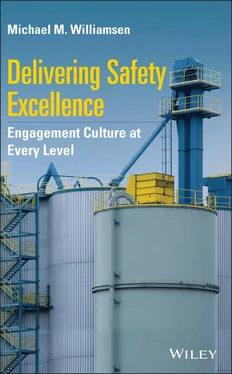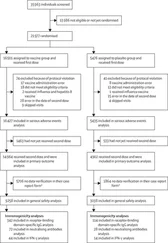Thus, Aaron returns to his decision of a commitment to getting rid of the worst apple. He must take the lead in doing whatever it takes to resolve his personnel issue. ER cannot be an excuse for Aaron in this matter. If Aaron is to run the race set before him, then he must personally be successful in getting over the hurdles as they come up .
As this saga unfolds, in however long it takes, the second part of the weak safety culture strategy has Aaron beginning a process of mentoring the other few safety staff members in order to help them deliver better performance. Aaron plans out the needed steps for success. As a part of this improvement strategy he also decides how he will give them the needed personal appreciation/recognition for good performance as it occurs. Personal, frequent, sincere feedback for a job done well is a true asset in lifting the performance of an individual and an organization. Such reinforcing feedback is also a necessity for the team comprised of the various individuals who are keeping all the moving parts going in the correct directions. Aaron wishes he had been given this kind of reinforcing feedback, but no need to whine about past events. Therefore, he realizes that, “I must take responsibility for what I can do now to improve our lot. If it is to be, it is up to me; so suck it up buttercup. Here we go!”
And then a significant surprise occurs when his best trainer, who quit because of the worst apple, comes back and tells Aaron that if he can get rid of the bad apple he would like to come back and help the department to improve the company's safety performance .
Aaron digs into the many difficulties of building a successful case necessary to remove his poorly performing employee. As he does so there is welcome relief from the long, hard grind in his next task; building the skills of the safety department's other resources. These two very different tasks are both about building personal relationship skills which are necessary for a team to function well with positive reinforcement, adult correction and skill building. Aaron smiles as he realizes this part of the plan to improve safety is coming together. But then there is still the cloud of a just plain sick safety culture that rains down on all the employees every day. How to “eat” this next elephant in the room will be just as challenging, if not more so. After his many discussions with the Doc, Aaron recognizes that applying the classic safety tools will do little or nothing to improve safety performance at their RIF plateau of 10+. These standard safety approaches will not address the real issue of a very weak safety culture. He writes down the “usual suspects” and thinks through what the result would be if this was all he planned to do:
The OSHA compliance approach of necessity has a condition centric focus. Aaron's injury and incident information show that facility physical conditions (and not personnel actions) account for very few of the injuries. Furthermore, the compliance tool is always reactive to an event that has already occurred. What is needed is a proactive strategy which will prevent incidents from occurring. His compliance audits have strong scores, the basics are in place. But his organization's current safety culture management has no thought of improving the underlying culture, just keep doing the same things and hope to get better;” The beatings will stop when the safety performance improves”
Aaron did not give high marks to the anemic data from the “program of the month” behavior based safety (BBS) which was in place before he took over. The project kicked off well, but then faded within a few months as all scores seemed to magically get to excellent, even though injuries continued to occur. Aaron picked up an article the Doc sent him and reached the same revelation that was explained by the probability equation from Dr. Dan Petersen; the fewer observations that highlighted safety problems, the more observations are required to be statistically significant. Dr. Petersen's article provided statistical insights not normally considered by BBS users:
Limitations of Safety Observation Sampling
Formula for calculating effectivenessN = 4(1−P)/(Y2)(P)where: N = total number of observations required, P = percentage of unsafe observations/actions, Y = desired accuracy.If desired accuracy Y is 10% and unsafe actions P are 10%, then N = 3600 required observations.With 1% unsafe actions P and 10% desired accuracy Y, then N = 39 600 observations to be required.What are the manpower requirements required for 39 600 observations?
The BBS process plateaus before the injury rate declines to world‐class low levels. The bottom line is that more and better tools are needed for improvement. 1
As with quality improvement: you cannot inspect quality in, nor can you observe safety action levels enough to achieve excellence. You must fix the upstream processes that deliver the necessary downstream performance. The safety improvement culture must go beyond another observation and/or compliance program and into improving the safety culture. Such improvement must ultimately move beyond the basics which are of foundational importance, but only help to deliver world‐class results. As Aaron searches for effective safety processes he finds that the literature does not have much in the way of other tools to use. The majority of the references emphasize reactive, fundamental government regulations and the soon plateaued observation program of the month. Aaron knows he has to go beyond this approach, but he is not all that certain of what can be used to engage the minds and actions of his people.
In order to answer this dilemma Aaron goes to his desk, picks up the business card, and makes the call. The Doc picks up and listens intently as Aaron explains his safety culture successes, failures, and struggles over the phone. When asked “What has really happened to cause all the injuries?” Aaron comments about the safety filter discussion they had during the interview process ( Chapter 1). Aaron's organization, with a RIF of about 10, has plenty of holes in the various safety filters/barriers of management systems, working conditions, and human behaviors. The high RIF rate tells him that the holes in these safety barriers often line up resulting in injuries that frequently occur. Last year Aaron's company experienced 90 recordable injuries, of which 39 were lost time cases. This year when the holes lined up, a fatality occurred, in a classic example of H.W. Heinrich's controversial predictive model. What is needed is to plug these holes. Aaron and the Doc agree to carry on an in‐depth conversation while on site. During this face‐to‐face conversation they will discuss how to significantly improve the safety culture of Aaron's company. In turn, this process will lead to the real on‐site work necessary to improve the weak safety culture.
Aaron “sort of” feels good about this approach. Yes, moving beyond merely talking about safety improvement is the correct thing to do. However, he knows that he and his company are now about to head into the long, challenging work of actually accomplishing a significant safety culture improvement for the more than 1000 employees of the company. Moving from talk to walk is never easy, but is always a necessity if any lasting improvement is to occur. Status quo won't provide any improvement for his many friends at work who experience significant injuries each year. Once again, Aaron is committed to taking the next step in a marathon journey to safety culture excellence. There are no short cuts, there are no quick fixes. The real work is about to begin, and it won't be easy. It reminds him of the story about the person waking up from a dream in which he was a butterfly going from flower to flower. For a moment he didn't know if he had been dreaming about being a butterfly or if he was really a butterfly having a nightmare!
Читать дальше












